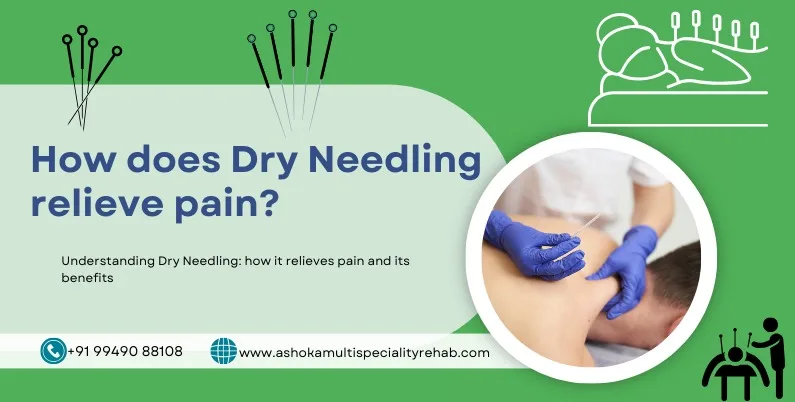Understanding Dry Needling: How It Relieves Pain and Its Benefits
Dry needling has emerged as a popular therapeutic technique for managing pain and enhancing physical function. Although it shares similarities with acupuncture, dry needling is a distinct approach with its own set of techniques and benefits. This blog will explore what dry needling is, how it alleviates pain, its benefits, potential side effects, and where you can find the best dry needling services in Hyderabad.
What is Dry Needling?
Dry needling is a treatment method that involves inserting thin, solid needles into specific points in the body, called trigger points or myofascial trigger points. These points are typically tight, sensitive areas within muscles that can cause pain and discomfort. Unlike acupuncture, which is rooted in traditional Chinese medicine and focuses on balancing energy flow (Qi), dry needling is based on Western anatomical and physiological principles.
The needles used in dry needling are usually very fine and are inserted into the skin at various depths, depending on the target area and the practitioner’s approach. The goal is to stimulate the trigger points, which helps release muscle tension, improve blood flow, and reduce pain.
How Does Dry Needling Relieve Pain?
Dry needling relieves pain through several mechanisms:
Muscle Relaxation: Trigger points are often the result of muscle overuse, injury, or poor posture, leading to localized areas of muscle tightness. Inserting needles into these points can help release the tight bands of muscle tissue, leading to a reduction in muscle tension and pain.
Increased Blood Flow: The insertion of needles into trigger points can cause a local inflammatory response, which increases blood flow to the affected area. Improved circulation helps deliver nutrients and oxygen to the muscle tissues while removing metabolic waste products that contribute to pain.
Neurological Effects: Dry needling can influence the nervous system by altering the way pain signals are processed. By stimulating the trigger points, the technique can help disrupt the pain cycle and enhance the body’s natural pain control mechanisms.
Endorphin Release: The procedure can stimulate the release of endorphins, which are natural pain-relieving chemicals produced by the body. Endorphins help diminish the perception of pain and improve overall well-being.
Restoration of Normal Function: By targeting and treating trigger points, dry needling can help restore normal muscle function and range of motion. This can be particularly beneficial for individuals suffering from chronic pain or restricted movement due to muscle dysfunction.
Benefits of Dry Needling
Dry needling offers a range of benefits for individuals dealing with various musculoskeletal issues. Some of the key advantages include:
Effective Pain Relief: Many patients experience significant pain relief following dry needling sessions. The technique is particularly effective for treating conditions such as myofascial pain syndrome, tension headaches, and chronic muscle pain.
Improved Range of Motion: By addressing trigger points and reducing muscle tightness, dry needling can enhance flexibility and range of motion. This is particularly beneficial for individuals recovering from injuries or dealing with conditions that limit their physical activity.
Enhanced Recovery: Athletes and individuals undergoing physical rehabilitation may benefit from dry needling as it aids in faster recovery from muscle strains and injuries. The technique can help reduce muscle soreness and speed up the healing process.
Reduced Muscle Tension: Dry needling is effective in relieving muscle tension, which can improve posture and alleviate discomfort associated with conditions like fibromyalgia and temporomandibular joint (TMJ) dysfunction.
Minimal Side Effects: Compared to other invasive procedures, dry needling has relatively few side effects. Most patients report only mild discomfort during and after the treatment, making it a well-tolerated option for many individuals.
Side Effects of Dry Needling
While dry needling is generally considered safe, it is important to be aware of potential side effects:
Soreness: Some patients may experience soreness at the needle insertion sites, similar to a mild muscle ache. This discomfort is usually temporary and subsides within a few hours to a day after the treatment.
Bruising: Occasionally, small bruises may develop around the needle insertion points. This is generally harmless and resolves on its own within a few days.
Bleeding: Although rare, minor bleeding can occur at the needle insertion sites. This is usually minimal and does not pose a significant risk.
Dizziness or Lightheadedness: In some cases, patients may feel lightheaded or dizzy during or after the procedure. This is often due to the body’s response to the needle insertion and typically resolves quickly.
Fatigue: Some individuals may feel fatigued following dry needling, which is usually a sign that the body is responding to the treatment. Adequate rest and hydration can help alleviate this effect.
Where to Get the Best Dry Needling in Hyderabad
For those seeking high-quality dry needling treatment in Hyderabad, it’s important to choose a clinic with experienced practitioners and a reputation for excellence. One such esteemed facility is the Ashoka Multispeciality Rehabilitation Centre.
Conclusion
Dry needling is a valuable therapeutic technique that offers effective relief from pain and muscle tension. By targeting trigger points and stimulating muscle tissue, it helps improve blood flow, reduce discomfort, and enhance overall function. While dry needling is generally safe and well-tolerated, it is important to be aware of potential side effects and consult with a qualified practitioner.
For those in Hyderabad seeking top-notch dry needling services, Ashoka Multispeciality Rehabilitation Centre is an excellent choice. With its skilled team and dedication to patient care, the centre provides a comprehensive and effective approach to pain relief and rehabilitation. Whether you’re dealing with chronic pain, muscle tension, or recovering from an injury, Ashoka Multispeciality Rehabilitation Centre offers the expertise and support you need to achieve optimal health and well-being.

